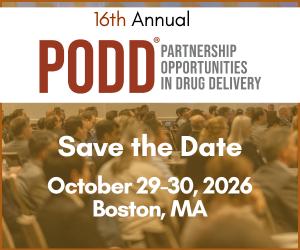
Where do you see the field of long-acting delivery evolving?
The field of long-acting drug delivery is set for substantial growth and innovation, poised to transform treatment options for various medical conditions. Key areas requiring innovation include enhancing bioavailability, improving compatibility with hydrophilic molecules, controlling burst release, ensuring compatibility with injection devices, sustainable manufacturing, developing long-acting oral formulations, exploring drug combinations, personalized medicine and reducing costs. Right now, one of the most relevant challenges is to find better ways to improve compatibility with auto-injector devices.
For injections, ideally, you want a long-acting formulation that behaves like water or a similar solution. Typically, we use polymeric systems for long-acting formulations that either need to be made into suspensions or are made into gels, which are too viscous for the device systems. This presents a real challenge and is the reason why technologies like lipidation for peptides, to extend their half-life to a week, have been successful. We will either have to develop devices that are more compatible with suspensions or gel solutions, or we will need to find new technologies that can extend the half-life of the drugs without altering the solution properties too much.
Is the challenge more the viscosity of the injection or is the challenge more the way that the delivery vehicle interacts with the drug?
Really, it’s both. If you have a very viscous solution, you will need to apply a lot more force to inject it which will be painful for the patient. This may not be a problem for certain therapeutic areas but for chronic diseases, it can lead to lower patient adherence. If you’re injecting a viscous formulation, you want the injection frequency to be at most once a month because it will be difficult to convince a patient to receive painful injections more frequently than that.
On the other hand, biodegradable microspheres cannot be in a ready-to-use aqueous solution as they will start to degrade. Therefore, we have two options: a dual-chamber device where one chamber stores the lyophilized powder and the other stores the aqueous vehicle. These components are mixed just before administration. However, one can imagine the complications associated with such systems, from timing the suspension to the difficulty for the patient in understanding the process at home. At AstraZeneca, the vehicle for an injectable suspension was changed from water-based to oil-based. The team succeeded in making their microspheres compatible with the oil, but generally our experience has been with aqueous solutions.
“Key areas requiring innovation include enhancing bioavailability, improving compatibility with hydrophilic molecules, controlling burst release, ensuring compatibility with injection devices, sustainable manufacturing, developing long-acting oral formulations, exploring drug combinations, personalized medicine and reducing costs.”
What about implants for long-acting therapies, as opposed to injections?
With an implant, due to its capability to significantly increase drug loading, treatment frequency can be reduced to every three months or even once a year; this offers a potential advantage for patients, provided the drug is well tolerated. However, implants cannot be self-administered and, in most cases, cannot be removed in the event of an unwanted reaction. Ultimately, the choice between implants and long-acting formulations in a device for injection depends on the therapeutic area, the nature of the molecule being used, route of administration, and patient age.
For subcutaneous injectables, particularly in the management of chronic diseases, there is a demand for user-friendly drug products, such as long-acting formulations in auto-injectors. However, for eye diseases in the posterior segment, patients could greatly benefit from an implant that allows them to reduce the dose frequency as much as possible.
Current technologies, such as polymeric depot systems, were initially developed for small molecules. However, issues such as burst control and options for hydrophilic molecules still occur. Despite this, several technology options are available on the market.
However, macromolecules such as protein-based drugs generally prove incompatible with many existing options. This may be due to the considerable stress required during formulation preparation, often involving organic solvents that can be incompatible with proteins, leading to drug degradation during manufacturing. Additionally, low bioavailability is observed for proteins/peptides formulated as depots for subcutaneous administration, necessitating significant increases in drug amounts and impacting costs.
Optimizing long-acting formulations for proteins and peptides using existing small molecule technology proves exceptionally challenging. Instead, approaches such as conjugation, fusions with biologic molecules, and transient conjugation (pro-drug) methods are proving more effective for weekly dose regimens. These strategies allow for a solution as a final formulation, ensuring compatibility with devices for patient self-administration at home.
“Approaches such as conjugation, fusions with biologic molecules, and transient conjugation (pro-drug) methods are proving more effective for weekly dose regimens.”
Are we seeing trends in the indications long-acting formulations are being applied to?
The application of long-acting formulations spans a wide range of therapeutic areas, reflecting the growing demand for sustained-release medications across various medical conditions. Examples include chronic disease management such as diabetes, obesity, and HIV; hormonal therapy; pain management; and oncology.
What kind of technology is needed to extend beyond one week?
The microparticle technology we use is very challenging to manufacture. As an alternative, we have gel formulations, but they tend to have a burst effect when being delivered so the patient can get something like twenty percent of the drug in the first hour after administration for a drug meant to be delivered over the course of three months. What we really want is a constant rate of release. This is mechanistically driven by diffusion and degradation of the polymer, which is difficult to control.
“Long-acting oral administration presents a considerable opportunity to improve patient adherence, provided we can make it financially viable for payers.”
What are some approaches to this?
One approach is to use a pro-drug by attaching the molecule with a polymer, which normally would increase the time of circulation once it’s in the blood. The release of the drug is controlled by detaching from the polymer via pH or/and temperature. This way you have a solution and not a suspension, which makes the compatibility with the device more manageable. Depending on the drug potency and stability of the prodrug, you can even develop a multi-dose formulation in a pen device.
Anything else?
We've delved deeply into long-acting injectables, yet I see the real potential for groundbreaking advancements in long-acting formulations through oral administration. We’re also witnessing the emergence of other promising technologies in early-stage development. Long-acting oral administration presents a considerable opportunity to improve patient adherence, provided we can make it financially viable for payers.









